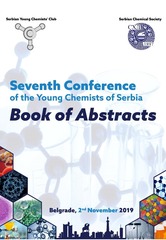Приказ основних података о документу
Comparison of strength of metal-hydrogen interaction energies between cisplatin and transplatin molecules and different hydrogen donors
| dc.creator | Veljković, Dušan Ž. | |
| dc.creator | Đunović, Aleksandra B. | |
| dc.creator | Zarić, Snežana D. | |
| dc.date.accessioned | 2022-07-01T15:09:13Z | |
| dc.date.available | 2022-07-01T15:09:13Z | |
| dc.date.issued | 2019 | |
| dc.identifier.isbn | 978-86-7132-071-9 | |
| dc.identifier.uri | http://cherry.chem.bg.ac.rs/handle/123456789/5379 | |
| dc.description.abstract | Early experimental and theoretical evidences of the existence of platinum-hydrogen interactions emerged more than four decades ago [1]. Although metal atoms are not usually seen as hydrogen atom acceptors, many crystallographic studies as well as our recent quantum chemical study, showed that they can be involved in very strong hydrogen bonding [2]. In this work, energies and geometries of X-H/Pt interactions involving cisplatin and transplatin molecules as hydrogen atom acceptors and different hydrogen atom donors were evaluated. Interaction energies and optimal geometries were calculated using MP2/aug-cc-PVDZ level of theory. Cambridge Structural Database search was performed and all structures containing cisplatin and transplatin molecules involved in X-H/Pt interactions were extracted. Geometrical parameters important for the analysis of X-H/Pt interactions were statistically analysed. Results indicated that there are significant differences in metal-hydrogen bonding between cisplatin and transplatin molecules. The energy of the strongest X-H/Pt interactions involving cisplatin molecule are calculated to be EO-H/cis-Pt = –5.97 kcal/mol while interaction energy of the strongest X-H/Pt interactions involving transplatin molecule was calculated to be EO-H/trans-Pt = –4.43 kcal/mol. Electrostatic potential maps were calculated for both cisplatin and transplatin molecules and used to explain trends in interaction energies. Results of interaction energies calculations were in excellent agreement with the results of statistical analysis of crystallographic data. References 1. E. R. T. Tiekink, Coord. Chem. Rev., 2017, 345, 209. 2. G. V. Janjić, M. D. Milosavljević, D. Ž. Veljković, S. D. Zarić, Phys. Chem. Chem. Phys. 2017, 19, 8657. | sr |
| dc.language.iso | en | sr |
| dc.publisher | Beograd : Srpsko hemijsko društvo | sr |
| dc.relation | info:eu-repo/grantAgreement/MESTD/Basic Research (BR or ON)/172065/RS// | sr |
| dc.rights | openAccess | sr |
| dc.rights.uri | https://creativecommons.org/licenses/by/4.0/ | |
| dc.source | Seventh Conference of the Young Chemists of Serbia, Book of Abstracts, Belgrade, 2nd November 2019 | sr |
| dc.title | Comparison of strength of metal-hydrogen interaction energies between cisplatin and transplatin molecules and different hydrogen donors | sr |
| dc.type | conferenceObject | sr |
| dc.rights.license | BY | sr |
| dc.citation.spage | 156 | |
| dc.citation.epage | 156 | |
| dc.type.version | publishedVersion | sr |
| dc.identifier.fulltext | http://cherry.chem.bg.ac.rs/bitstream/id/29793/Mladi_hemicari_Veljkovic_1.pdf | |
| dc.identifier.rcub | https://hdl.handle.net/21.15107/rcub_cherry_5379 |


